Altamura Semolina Bread incorporates semolina flour as well as a sponge of whole wheat and all-purpose flour for a beautiful, rustic texture. It’s a delightful bread! I enjoy breads made with semolina flour and this bread is no exception.
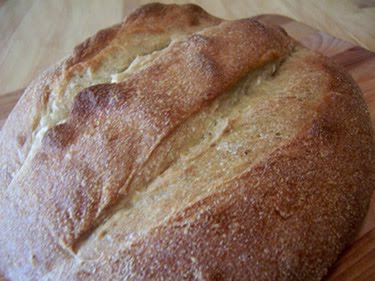
Semolina flour feels gritty when dry, but doughs made with this flour become smooth and silky and very easy to work with.
Altamura is a town in Puglia, Italy where they grow Durum wheat. This wheat is so special that the Altamurans have achieved the DOP (Protected Designation of Origin) for their breads which are made with semolina flour milled from the durum wheat grown in the area.
Although my version is made with flour from the farmer’s market, and not flour from Italy, it is delicious nonetheless.
Altamura Semolina Bread
Makes: 1 small loaf
The recipe for this Semolina bread is from Bread Matters: The state of modern bread and a definitive guide to baking your own. For more information about the book, please read my review of Bread Matters
Sponge:
- 1/4 heaping teaspoon active dry yeast
- 2/3 cup Water
- 1/2 cup plus 1 tablespoon unbleached all-purpose flour
- 1/2 cup plus 1 tablespoon stoneground breadmaking whole-wheat or graham flour
- 1/2 cup Sponge (from above) *
- 1 2/3 cups Semolina flour
- 3/4 teaspoon Sea salt
- 1/2 cup plus 2 tablespoons Water
* Usually, a sponge is created and then used up. However, for this semolina bread, some of the sponge is left over. You have a couple of options for dealing with the extra sponge: 1) use all of the sponge and add more flour, if necessary, to compensate. Or, 2) turn your sponge into a leaven by refreshing it with flour and water (but no yeast). Gradually, it will become a leaven or “wild yeast” starter.
To refresh it, add 1/2 cup plus 1 tablespoon unbleached all-purpose flour, 6 1/2 tablespoons whole wheat flour, and a scant 1/2 cup water and mix thoroughly. You would then use this as a levain (starter) and it could replace the sponge the next time you make this bread. You’ll need to let the dough rise a bit longer, but the flavor and texture should be the same.
Make the Sponge
To make the sponge, dissolve the yeast in the water. Add the flours and mix to a soft sponge. There is no need to mix it vigorously. It will ferment for a long time so the naturally occurring enzymes and acids will develop the gluten.
Put the sponge in a bowl with plenty of room for expansion (up to 3 times its volume) and cover with a lid or plastic bag to conserve moisture. Let it ferment at room temperature for 16-48 hours. During this time the sponge will rise and collapse. The yeast cells will multiply and the acids will begin to develop.
I marked it with the date and time so I could remember how long to let it rest on the counter. I made the sponge on Sunday, then made the dough and baked it on Tuesday.
Here is the dough after resting on the counter for 2 days. You can see how it has risen and then fallen.
Make the Dough
Add the semolina, salt, and water at a temperature that will finish the dough at about 81 degrees F.
Knead it well until the dough is silky and stretchy. Note: If it’s hard to stretch and the dough seems to tear easily, add some more water. It takes semolina a little while to absorb its full complement of water because the granules are bigger than flour. Be prepared to adjust the dough with more water, or flour, while you are kneading.
Put the dough in a bowl. Cover it with plastic wrap and let the dough rise for1-2 hours. This is the dough after rising on the counter for 1 1/2 hours.
Mold into an oval loaf that is slightly tapered at the ends, the shape of a rather fat football. Dip the loaf into a bowl of semolina flour so that the whole thing is covered. The semolina coating gives a wonderful crunch and nutty flavor to the crust. If the dough is too dry for the semolina to stick to it, wet it and try again. I just rolled it in the semolina on the counter to cover it.
Dust a lined baking sheet with semolina flour and place the molded loaf on it. I put my loaf on a parchment-lined peel dusted with semolina flour so I could slide it off onto the hot baking stone. Cover the loaf with plastic wrap.
Allow plenty of time for a full proof so the bread will expand.
When the loaf is well risen, take a sharp blade (I used a serrated bread knife) and make 2 cuts, from point to point, about 3/8 inch apart at their widest and following the “contours” of the loaf. I followed the contour for the cut on the right but I didn’t quite get the one on the left curved the right way. We’ll get it right one day!
Slide the loaf onto a baking stone that has been preheated with the oven as hot as possible — 450 to 470 degrees F.
Close the door as quickly as possible and bake the loaf for about 30 minutes, reducing the oven temperature by 60 to 70 degrees after 10 minutes or so. I preheated my oven to 475 degrees F. and baked the loaf for ten minutes at that temperature, then lowered it to 425 degrees F to finish baking.
The finished loaf should have a golden-brown crust that is quite hard immediately after baking.
The 2 cuts should have helped the inside of the dough to expand and push up a little through the crust. There should be a pleasing contrast between the cuts and the semolina-dusted crust. Allow the bread to cool before slicing or serving.
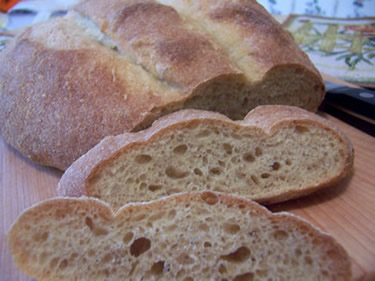
It tastes great toasted with butter or jam. I particularly like it with Pear Pineapple Jam
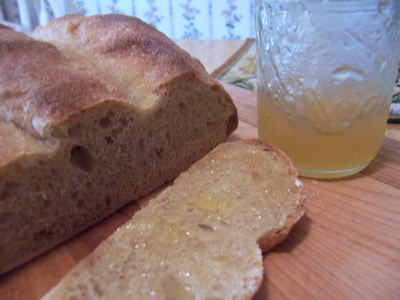
Bread Baking Day #24
This bread has been submitted to Bread Baking Day #24 — Mixed Breads. This bread qualifies as a mixed bread since it utilizes a sponge of whole wheat, and all-purpose flour in addition to the semolina flour.
To learn more about BBD #24, click here.
Be sure to check out all of the fabulous breads in the BBD #24 Roundup. You’ll want to start baking once you see them. I already want to start baking them. So many breads…so little time. Enjoy!
Happy Baking!
Cathy
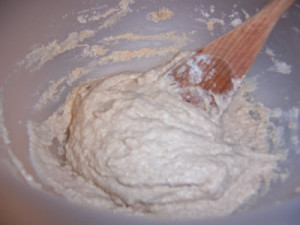
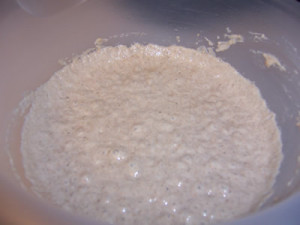
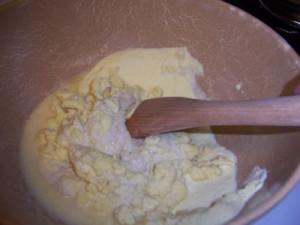
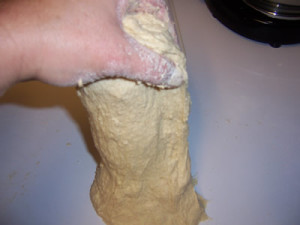
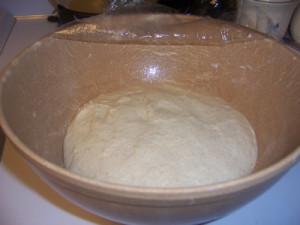
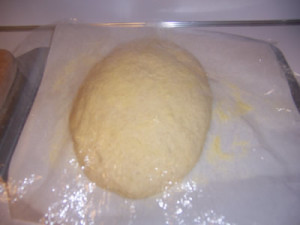
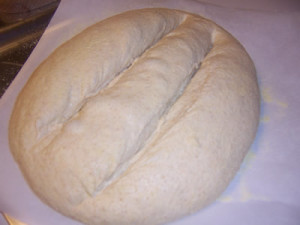
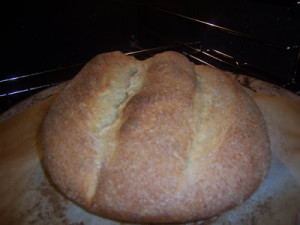
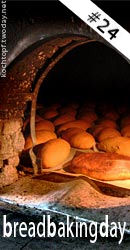
IDania says
Cathy,
Expectacular bread!!!
I will try making this recipe some time. It’s very interesting…
Round-up for BBD #24 is Published at:
http://elaromadeidania.blogspot.com/2009/11/bbd-24-round-up-resumen.html
Thank you for your participation,
IDania
Cathy (breadexperience) says
Thanks IDania! I enjoyed participating in BBD #24. Thanks for hosting it. I need to check out all of the other wonderful breads in the roundup. Yum!
Anonymous says
This recipe came out quite beautifully. I did add 1/4 cup sourdough starter and did not dust with the semolina flour , Forgot. The bread still got a decent colour and came out withe a crisp crust that softened as the bread cooled. It looked quite attractive and tasted great. Thanks for sharing this recipe.
Cathy W. says
I’m so glad you enjoyed the bread. Happy Baking!
Cakes and Curries says
Hi ! How do I store the remaining sponge and how long will it stay fresh ?
Cathy W. says
Hello, generally a sponge is created and then used up. However, since there is leftover sponge from this bread, you can refresh it with flour and water (but don’t add any additional yeast). Gradually, it will become a leaven or “wild yeast” starter.
If you want to refresh it, add 1/2 cup plus 1 tablespoon unbleached all-purpose flour, 6 1/2 tablespoons whole wheat flour and a scant 1/2 cup water and mix thoroughly. You would then use this as a levain (starter) and it could replace the sponge next time you make this bread. You’ll need to let the dough rise a bit longer, but the flavor and texture should be the same.
Vicky says
Hi Cathy! Not sure if you’ll see this, as it appears I’ve found this recipe a bit late! I plan on starting the sponge today or tomorrow and was wondering just how much of it is left. Enough to make a second loaf? If not, I may play around with the remaining ingredients to create a larger loaf.
Thanks in advance for your input!
Cathy says
Hi Vicky,
You’re not too late. You’re just in time. It’s been awhile since I’ve made this bread, but looking at the ingredients, it seems that you could make just make a bigger loaf by using the entire sponge, then add more flour until you get the consistency you’re looking for. Let me know how it goes.
Happy Baking!
Cathy
leona says
I made this today. I used all of the sponge (it had about 50 hours at room temp) and added enough extra water while mixing to make quite a wet dough (as is my preference). I don’t know how much I added in the end! I shaped mine into a batard after the bulk ferment and baked it under a roasting tin. I gave it 25 minutes like this spraying steam into the oven twice. It has come out beautifully. I can’t wait to taste it, smells amazing!
Cathy says
Sounds fabulous! Thanks for sharing.